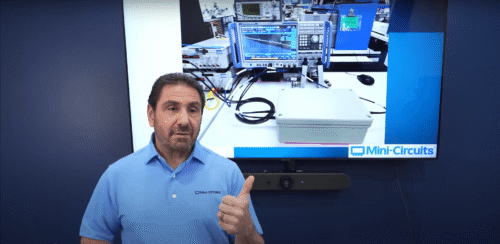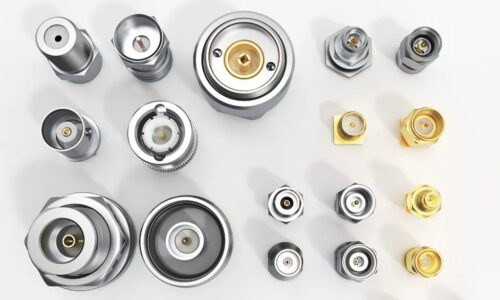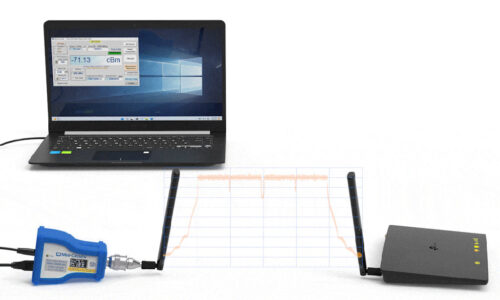Understanding Power Splitter/Combiner Power Handling with Coherent and Non-Coherent Signals
Denis Loxha, Mini-Circuits Applications
Introduction
A Power Splitter/Combiner is a passive device that can be used for two reciprocal functions: a single signal may be divided into multiple outputs, or in the opposite direction, multiple input signals are combined into a single output. In case of an N-port splitter, the input signal will be divided into N output ports. When used as an N-port combiner, the N inputs will be combined into an output signal from a single port.
Applications include test instruments, laboratory and production test systems, power amplifier subsystems, and many types of signal processing. The most common type of power splitter/combiner has equal amplitude and 0º phase difference among the N ports, as well as identical impedances. As a splitter, the input-to-output loss depends on N — e.g., 3 dB loss for 2 ports, 6 dB loss for 4 ports, etc. — plus a small insertion loss through the internal circuitry. As a combiner, the single port output is the sum of the N port inputs. Phase shifts or unequal amplitudes required for signal processing are typically achieved with external circuits, but some commonly-used configurations may be included in the power splitter/combiner package.
Another feature of splitter/combiners is isolation between the multiple ports. The internal circuitry of the device is designed for cancellation of signals passing from one of the N ports to any other. To accomplish good isolation, as well as maintain accurate power division, the internal circuits are balanced, with any imbalance directed to a load resistor, where its energy is dissipated. The ability of a power splitter/combiner to handle unbalanced conditions is a key factor in its proper implementation, since the rating of the load resistor places a limit on dissipation.
The focus of this application note will be to demonstrate how combining N input signals affects the power handling of the device, particularly when used with non-coherent signals.
Understanding the Coherence of Signals
Various definitions are used to explain the phase coherence of input signals. Perhaps the simplest is that coherence is when two signals have the same frequency and maintain a constant phase offset. In other words, the relative phase Δφ (Figures 1 & 2) between the two signals stays constant over time. Conversely, if the two signals do not have constant phase relative to one another then they are considered non-coherent, as illustrated in Figure 3.



Consider a 2-way power splitter. A single signal is the source, which is split into two output signals, each with half the original power (-3 dB). There is no phase difference between the outputs since they are derived from the same input signal. The outputs are thus coherent. If we introduce a time delay in one of the signal paths, such as a section of transmission line, there will be a phase difference, but it will remain constant, so the signals are still coherent. With these coherent signals, the signal paths are balanced and virtually no power is dissipated by the load resistor.
In the other direction — as a power combiner — if the two inputs are coherent and identical in amplitude, the device is balanced and there will be no power in the load resistor. But if there are any differences in the input signals (non-coherent), the system is unbalanced, resulting in power being sent to the load resistor. The amount of power dissipated due to non-coherent combining must not exceed the ratings of the load resistor.
In general, non-coherent signals have differences in amplitude, phase and/or frequency that will result in significant unbalanced power being dissipated. The dissipated power may range from a minor amount to the total input power.
Mini-Circuits’ Definition of Non-Coherent Signals
The power combiner exhibits insertion loss that varies according to the amplitude and phase relationship of the signals that are being combined. In many of our splitter/combiners, when we specify ratings for power as combiner, on our footnote we state “As a combiner of non-coherent signals max power per port is XX-watt power rating divided by number of ports.” In other words, the power handling capability of the power combining is limited by power handling of the internal resistor(s). The input power of each combined signal cannot exceed XX-W/N (where N is number of ports). For example, if we have a 2-way power splitter with a rated internal dissipation of 0.8W, then the maximum power for each port is 0.8W/2, or 0.4W per each port. If the two input signals are equal in amplitude and are in-phase (shown in Figure 4) then the insertion loss is zero, thus the power rating would be the same rated power as a splitter, divided by N-ports. Thus, a 2-way splitter rated at 10 watts can handle two signals of 5 watts if the signals were perfectly frequency and amplitude coherent.
If the two signals are at different frequencies, the insertion loss will equal the theoretical insertion loss. In other words, if two signals at different RF frequencies are being added, then each signal will appear at the S port with a 3 dB loss. The internal resistor absorbs the 3 dB power loss for each signal.
However, if the signals are 180° out-of-phase (as shown in Figure 5) the insertion loss is infinite. In this case, there would be no power at the output and the total power would be dissipated by the resistor(s).













